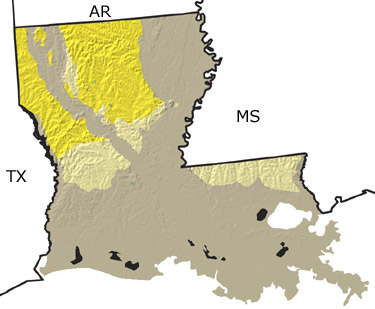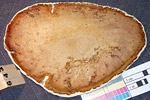

Louisiana, US |
|||||||||||||||||||||||||||||||||||||||||||||||||||||||||||||||
|
|||||||||||||||||||||||||||||||||||||||||||||||||||||||||||||||
Paleontology and geologyThe Precambrian: There are no Precambrian rocks known from Louisiana. Louisiana, as such, did not exist until later, when North and South America separated during the breakup of Pangea. The Paleozoic: Paleozoic rocks older than the Devonian appear to be absent from Louisiana, even in the subsurface. Any sediment that might have accumulated in the marine environment that occupied this region from the mid-Cambrian through the Silurian has been pushed north and out of the state by later mountain building. Devonian and Carboniferous rocks are present well below the surface, but are primarily igneous and metamorphic. Gravels brought down into Louisiana by rivers and streams contain molds of molluscs, crinoids, brachiopods, and trilobites of Late Paleozoic age, indicating that shallow seas covered the general area at this time. The Mesozoic: Shallow seas covered Louisiana throughout the Mesozoic. The Gulf of Mexico began to develop as the supercontinent of Pangea split apart, forming a sea with restricted flow to the main ocean. Evaporation rates were high, particularly during the Jurassic, and thick layers of salt formed on the sea floor. Most Mesozoic units are known only from drill cores; however, a few Cretaceous outcrops exist and shark teeth have been recovered from these. The Cenozoic: Cenozoic deposits cover most of Louisiana. These deposits were formed as the sea advanced and retreated several times during this interval, producing a complex interfingering of marine and non-marine beds. Over the course of the Cenozoic, the state was built farther and farther out into the widening Gulf of Mexico, providing large areas of coastal plain habitat for camels, mastodons, and other mammals.
|
|||||||||||||||||||||||||||||||||||||||||||||||||||||||||||||||
Links to more on Louisiana paleontology |
|||||||||||||||||||||||||||||||||||||||||||||||||||||||||||||||
Organizations
|
|||||||||||||||||||||||||||||||||||||||||||||||||||||||||||||||
|
site tour |
about the site |
site map |
site credits |
page credits |
help |
FAQs |
contact |
||

